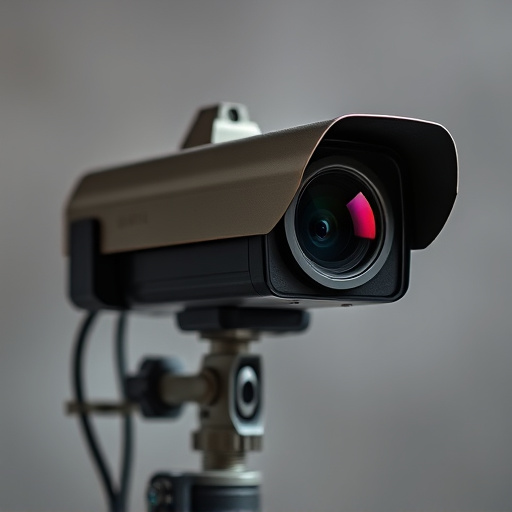Mounting dummy cameras under eaves provides discreet, comprehensive security for homes or businesses with limited mounting options or vandalism concerns. Positioned strategically within the roofline's shadow, these cameras deter intruders while capturing wide-angle views, offering peace of mind. Ideal height is 1-2 feet below the eave for unobtrusive surveillance, adjusting for surrounding factors. Secure installations with high-quality brackets and matching materials camouflage the system from intruders. Avoid false impressions by placing clear, non-recording dummy cameras at genuine camera heights to deter potential threats while adhering to privacy laws.
Mounting dummy cameras under eaves can significantly boost your home or business security without breaking the bank. Understanding the strategic benefits of this technique—from enhanced visual deterrence to reduced installation costs—is key. This guide delves into the optimal mounting height for both visibility and discretion, offers practical installation tips, and highlights legal considerations. By following these best practices, you can leverage the power of mounting dummy cameras under eaves effectively.
- Understanding the Benefits of Mounting Dummy Cameras Under Eaves
- Choosing the Right Height for Optimal Visibility and Discretion
- Installation Tips and Tricks for a Secure Fit
- Legal Considerations and Best Practices for Fake Security Camera Placement
Understanding the Benefits of Mounting Dummy Cameras Under Eaves
Mounting dummy cameras under eaves offers a strategic advantage in home or business security. This method allows for discreet placement, as the cameras are hidden from direct view, making them an effective deterrent to potential intruders. By positioning the cameras under the roofline, you can capture wide angles of your property, providing comprehensive surveillance without compromising aesthetics.
This technique is particularly beneficial for areas with limited mounting options or where overt security equipment might be a target for vandalism or theft. The eaves offer a natural and secure location, ensuring the cameras are steady and protected from the elements. This strategic placement can significantly enhance overall security, giving peace of mind and an extra layer of protection to your space.
Choosing the Right Height for Optimal Visibility and Discretion
Choosing the optimal height for security camera placement is a delicate balance between visibility and discretion. For areas like rooftops or under eaves, opt for mounting dummy cameras at a height that offers clear line-of-sight while remaining relatively hidden from casual observation. A common rule of thumb is to position the camera’s lens approximately 1-2 feet (0.3-0.6 meters) below the edge of the eave or roofline. This height strikes a balance, providing adequate coverage without drawing unnecessary attention.
Consider the surrounding environment and potential obstacles like trees or adjacent structures when making your decision. Mounting dummy cameras slightly higher can help ensure a broader field of view and reduce the risk of obstructions, especially in dynamic environments. Conversely, positioning them too low might not provide enough vantage point for effective surveillance.
Installation Tips and Tricks for a Secure Fit
When mounting dummy security cameras, particularly under eaves, it’s crucial to ensure a secure fit that won’t be easily dislodged. One effective tip is to use high-quality brackets designed specifically for overhang installations. These brackets should have robust screws and anchors capable of penetrating the solid structure beneath the eaves. Additionally, aligning the camera’s field of view precisely is essential; consider using level tools to ensure the camera captures the desired area without any obstructions from nearby structures or foliage.
Another trick involves camouflage: integrate the mounting process seamlessly with your roofline. Use paint or materials that match your roof for a discreet setup. This approach, especially when combined with realistic-looking dummy cameras, can deter potential intruders as they won’t be easily able to identify active surveillance systems hidden from view.
Legal Considerations and Best Practices for Fake Security Camera Placement
When placing dummy security cameras, also known as fake cameras, it’s essential to balance effective deterrence with legal considerations. While mounting these devices strategically can significantly enhance home or business security, certain locations and methods require careful thought. One common practice that should be avoided is mounting dummy cameras directly under eaves or overhangs. Such placements can create the appearance of blind spots for real security systems, potentially leading to false alarm situations or legal issues if not executed properly. Local laws regarding surveillance equipment vary widely; thus, understanding your region’s regulations on camera placement and privacy rights is paramount before installing any security system, whether genuine or simulated.
Best practices dictate that fake cameras should serve as deterrents without compromising privacy rights. Opt for mounting them in clear view, preferably at heights that mimic real security camera positions. This strategy ensures they act as a strong psychological deterrent to potential intruders while avoiding legal pitfalls associated with hiding surveillance equipment. Additionally, consider the type of camera you choose; some models are designed to look like functional cameras but do not record footage, ensuring compliance with privacy laws and reducing the risk of unauthorized data collection.
Mounting dummy cameras under eaves is an effective strategy to enhance home security without sacrificing aesthetics. By understanding the benefits, choosing the right height for optimal visibility and discretion, following installation tips, and considering legal best practices, you can create a robust security system that deters potential intruders while maintaining a seamless look. Implement these guidelines, and you’ll have a reliable and subtle solution with your Mounting Dummy Cameras Under Eaves.
